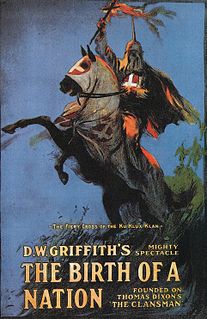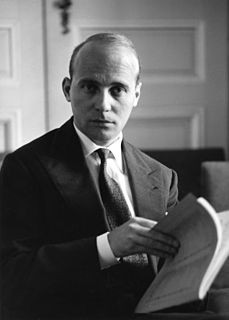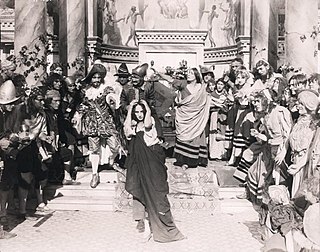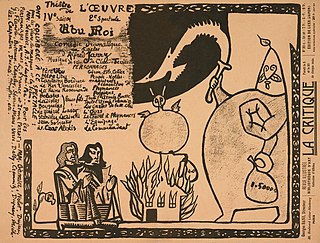 W
WL'Age d'Or, commonly translated as The Golden Age or Age of Gold, is a 1930 French surrealist satirical comedy film directed by Luis Buñuel about the insanities of modern life, the hypocrisy of the sexual mores of bourgeois society, and the value system of the Catholic Church. The screenplay is by Salvador Dalí and Buñuel. L'Age d'Or was one of the first sound films made in France, along with Miss Europe and Under the Roofs of Paris.
 W
WBallet Mécanique (1923–24) is a Dadaist post-Cubist art film conceived, written, and co-directed by the artist Fernand Léger in collaboration with the filmmaker Dudley Murphy. It has a musical score by the American composer George Antheil. However, the film premiered in a silent version on 24 September 1924 at the Internationale Ausstellung neuer Theatertechnik in Vienna presented by Frederick Kiesler. It is considered one of the masterpieces of early experimental filmmaking.
 W
WThe Birth of a Nation, originally called The Clansman, is a 1915 American silent drama film directed by D. W. Griffith and starring Lillian Gish. The screenplay is adapted from Thomas Dixon Jr.'s 1905 novel and play The Clansman. Griffith co-wrote the screenplay with Frank E. Woods and produced the film with Harry Aitken.
 W
WLe Chemin, Paysage à Meudon also known as Paysage avec personage, is an oil on canvas painted in 1911 by the artist, theorist and writer Albert Gleizes. The work was exhibited at the Salon des Indépendants during the spring of 1911, Paris; Les Indépendants, Musée moderne de Bruxelles, 1911; Galeries Dalmau, Exposicio d'art cubista, Barcelona, 1912; Galerie La Boétie, Salon de La Section d'Or, 1912. The painting was reproduced in the journal Le Siècle (1912) in an article titled Enquête sur le Cubisme, by Olivier Hourcade.
 W
WDanseuse au café is a large oil painting created in 1912 by the French artist and theorist Jean Metzinger (1883–1956). The work was exhibited in Paris at the Salon d'Automne of 1912, entitled Danseuse. The Cubist contribution to the 1912 Salon d'Automne created a controversy in the Municipal Council of Paris, leading to a debate in the Chambre des Députés about the use of public funds to provide the venue for such 'barbaric' art. The Cubists were defended by the Socialist deputy, Marcel Sembat. This painting was realized as Albert Gleizes and Jean Metzinger, in preparation for the Salon de la Section d'Or, published a major defence of Cubism, resulting in the first theoretical essay on the new movement, Du "Cubisme". Danseuse au café was first reproduced in a photograph published in an article entitled Au Salon d'Automne "Les Indépendants" in the French newspaper Excelsior, 2 Octobre 1912. The painting is now located at the Albright-Knox Art Gallery, Buffalo New York.
 W
WLe Déjeuner sur l'herbe – originally titled Le Bain – is a large oil on canvas painting by Édouard Manet created in 1862 and 1863. It depicts a female nude and a scantily dressed female bather on a picnic with two fully dressed men in a rural setting. Rejected by the Salon jury of 1863, Manet seized the opportunity to exhibit this and two other paintings in the 1863 Salon des Refusés, where the painting sparked public notoriety and controversy. The work is now in the Musée d'Orsay in Paris. A smaller, earlier version can be seen at the Courtauld Gallery, London.
 W
WLes Demoiselles d'Avignon is a large oil painting created in 1907 by the Spanish artist Pablo Picasso. The work, part of the permanent collection of the Museum of Modern Art, portrays five nude female prostitutes in a brothel on Carrer d'Avinyó, a street in Barcelona. Each figure is depicted in a disconcerting confrontational manner and none is conventionally feminine. The women appear slightly menacing and are rendered with angular and disjointed body shapes. The figure on the left exhibits facial features and dress of Egyptian or southern Asian style. The two adjacent figures are shown in the Iberian style of Picasso's native Spain, while the two on the right are shown with African mask-like features. The ethnic primitivism evoked in these masks, according to Picasso, moved him to "liberate an utterly original artistic style of compelling, even savage force."
 W
WDeux Nus is an early Cubist painting by the French artist and theorist Jean Metzinger. The work was exhibited at the first Cubist manifestation, in Room 41 of the 1911 Salon des Indépendants, Paris. At this exhibition the Cubist movement was effectively launched before the general public by five artists: Metzinger, Gleizes, Le Fauconnier, Delaunay and Léger. This was the first exhibition during which artists, writers, critics and the public at large encountered and spoke about Cubism. The result of the group show is a succès de scandale.
 W
WEn Canot is a Cubist oil painting created by Jean Metzinger in 1913. The work is referred to in various publications as Femme à l'ombrelle, Im Boot, Le Canot, En Bâteau, In the Canoe, The Boat, On the Beach, Am Strand, Im Schiff, V Člunu and Im Kanu. The painting was exhibited in Paris at the 1913 Salon d'Automne. The following year it was shown at Moderní umění, 45th Exhibition of SVU Mánes in Prague, February–March 1914. This "Survey of Modern Art" was one of the last prewar exhibitions in Prague. En Canot was exhibited again, in July of the same year, at the Galerie Der Sturm, Berlin. The painting was acquired from Herwarth Walden in 1916 by Georg Muche at Galerie Der Sturm.
 W
WFamily Quarrels is a comic opera in three acts with a libretto by Thomas Dibdin, and music principally by William Reeve. It was premiered in London at Covent Garden Theatre on December 18, 1802. The singers John Braham and Charles Incledon had leading roles in the opera, in which the comedian John Fawcett took the part of the pedlar Proteus.
 W
WFando y Lis is a 1968 Mexican film directed by Alejandro Jodorowsky in his feature length directorial debut. It is an adaptation of a play of the same name by Fernando Arrabal, who was working with Jodorowsky on performance art at the time. The film was shot in high-contrast black-and-white on the weekends with a small budget and was first shown at the Acapulco Film Festival in 1968.
 W
WDas Floß der Medusa is a secular oratorio by the German composer Hans Werner Henze. It is regarded as a seminal work in the composer's political alignment with left-wing politics.
 W
WLe Goûter, also known as Tea Time (Tea-Time), and Femme à la Cuillère is an oil painting created in 1911 by the French artist and theorist Jean Metzinger (1883–1956). It was exhibited in Paris at the Salon d'Automne of 1911, and the Salon de la Section d'Or, 1912.
 W
WThe Robert E. Lee Monument is an outdoor bronze equestrian statue of Confederate general Robert E. Lee and his horse Traveller located in Charlottesville, Virginia's Market Street Park in the Charlottesville and Albemarle County Courthouse Historic District. The statue was commissioned in 1917 and dedicated in 1924, and in 1997 was listed on the National Register of Historic Places.
 W
WMan on a Balcony, is a large oil painting created in 1912 by the French artist, theorist and writer Albert Gleizes (1881–1953). The painting was exhibited in Paris at the Salon d'Automne of 1912. The Cubist contribution to the salon created a controversy in the French Parliament about the use of public funds to provide the venue for such 'barbaric art'. Gleizes was a founder of Cubism, and demonstrates the principles of the movement in this monumental painting with its projecting planes and fragmented lines. The large size of the painting reflects Gleizes's ambition to show it in the large annual salon exhibitions in Paris, where he was able with others of his entourage to bring Cubism to wider audiences.
 W
WLa muette de Portici, also called Masaniello in some versions, is an opera in five acts by Daniel Auber, with a libretto by Germain Delavigne, revised by Eugène Scribe.
 W
WOlympia is a painting by Édouard Manet, first exhibited at the 1865 Paris Salon, which shows a nude woman ("Olympia") lying on a bed being brought flowers by a servant. Olympia was modelled by Victorine Meurent and Olympia's servant by the art model Laure. Olympia's confrontational gaze caused shock and astonishment when the painting was first exhibited because a number of details in the picture identified her as a prostitute. The French government acquired the painting in 1890 after a public subscription organized by Claude Monet. The painting is on display at the Musée d'Orsay, Paris.
 W
WParade is a ballet with music by Erik Satie and a one-act scenario by Jean Cocteau. The ballet was composed in 1916–17 for Sergei Diaghilev's Ballets Russes. The ballet premiered on Friday, May 18, 1917 at the Théâtre du Châtelet in Paris, with costumes and sets designed by Pablo Picasso, choreography by Léonide Massine, and the orchestra conducted by Ernest Ansermet.
 W
WThe Rite of Spring is a ballet and orchestral concert work by the Russian composer Igor Stravinsky. It was written for the 1913 Paris season of Sergei Diaghilev's Ballets Russes company; the original choreography was by Vaslav Nijinsky with stage designs and costumes by Nicholas Roerich. When first performed at the Théâtre des Champs-Élysées on 29 May 1913, the avant-garde nature of the music and choreography caused a sensation. Many have called the first-night reaction a "riot" or "near-riot", though this wording did not come about until reviews of later performances in 1924, over a decade later. Although designed as a work for the stage, with specific passages accompanying characters and action, the music achieved equal if not greater recognition as a concert piece and is widely considered to be one of the most influential musical works of the 20th century.
 W
WThe Satanic Verses is Salman Rushdie's fourth novel, first published in 1988 and inspired in part by the life of Muhammad. As with his previous books, Rushdie used magical realism and relied on contemporary events and people to create his characters. The title refers to the satanic verses, a group of Quranic verses that refer to three pagan Meccan goddesses: Allāt, Uzza, and Manāt. The part of the story that deals with the "satanic verses" was based on accounts from the historians al-Waqidi and al-Tabari.
 W
WScandals in art occur when members of the public are shocked or offended by a work of art at the time of its first exhibition or publication,.
 W
WTannhäuser is an 1845 opera in three acts, with music and text by Richard Wagner. It is based on two German legends: Tannhäuser, the mythologized medieval German Minnesänger and poet, and the tale of the Wartburg Song Contest. The story centers on the struggle between sacred and profane love, as well as redemption through love, a theme running through most of Wagner's work.
 W
WThe Spring is a large oil painting created in 1912 by the French artist Francis Picabia. The work, both Cubist and abstract, was exhibited in Paris at the Salon d'Automne of 1912. The Cubist contribution to the 1912 Salon d'Automne created a controversy in the Municipal Council of Paris, leading to a debate in the Chambre des Députés about the use of public funds to provide the venue for such 'barbaric' art. The Cubists were defended by the Socialist deputy, Marcel Sembat. This painting was realized as Albert Gleizes and Jean Metzinger, in preparation for the Salon de la Section d'Or, published a major defence of Cubism, resulting in the first theoretical essay on the new movement, Du «Cubisme». The painting forms part of the permanent collection of the Museum of Modern Art, New York City.
 W
WUbu Roi is a play by French writer Alfred Jarry, then 23 years old. It was first performed in Paris on December 10, 1896, by Aurélien Lugné-Poe's Théâtre de l'Œuvre at Nouveau-Théâtre, 15, rue Blanche, in the 9th arrondissement. The play—scheduled for an invited "industry" run-through, followed by a single public performance the next night—caused a riotous response in the audience and denunciatory reviews in the days after. It is considered a wild, bizarre and comic play, significant for the way it overturns cultural rules, norms, and conventions. To some of those who were in the audience on opening night, including W. B. Yeats and the poet and essayist Catulle Mendès, it seemed an event of revolutionary importance, but many were mystified and outraged by the seeming childishness, obscenity, and disrespect of the piece. It is now seen by some to have opened the door for what became known as modernism in the twentieth century. It is a precursor to Dada, Surrealism and the Theatre of the Absurd. It is the first of three stylised burlesques in which Jarry satirises power, greed, and their evil practices—in particular the propensity of the complacent bourgeoisie to abuse the authority engendered by success.